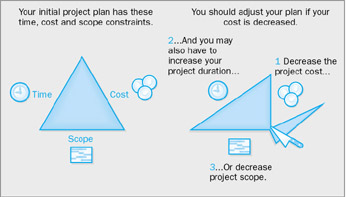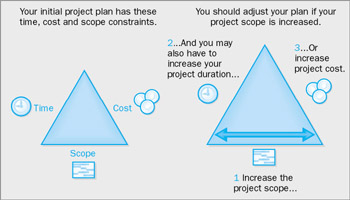Time, Cost, and Scope: Managing Project Constraints
Project management gets most interesting when you have to balance the time, cost, and scope constraints of your projects—“balance” as on a high wire. You could also think of juggling these constraints, or juggling them while on a high wire…well, you get the idea. Let’s return to the project triangle model. The project triangle illustrates the process of balancing constraints because the three sides of the triangle are connected, and changing one side of a triangle affects at least one other side. Here are some examples of constraint balance:
-
If the duration (time) of your project schedule decreases, you might need to increase bud get (cost) because you must hire more resources to do the same work in less time. If you can’t increase the budget, you might need to reduce the scope because the resources you have can’t do all of the planned work in less time.

If you must decrease a project’s duration, make sure that overall project quality is not unintentionally lowered. For example, testing and quality control often occur last in a software development project; if the project duration is decreased late in the project, those tasks might be the ones cut back. You must weigh the benefits of decreasing the project duration against the potential downside of a deliverable with poorer quality.
-
If the budget (cost) of your project decreases, you might need more time because you can’t pay for as many resources or for resources of the same efficiency. If you can’t increase the time, you might need to reduce project scope because fewer resources can’t do all of the planned work in the time you have.

If you must decrease a project’s budget, you could look at the grades of material resources for which you had budgeted. For example, did you plan to shoot a film in 35 mm when cheaper 16 mm film would do? A lower-grade material is not necessarily a lower-quality material. As long as the grade of material is appropriate for its intended use, it might still be of high quality. Another example: fast food and gourmet are two grades of restaurant food, but you may find high-quality and low-quality examples of each.
You should also look at the costs of the human and equipment resources you have planned to use. Can you hire less experienced people for less money to carry out simpler tasks? Reducing project costs can lead to a poorer-quality deliverable, however. As a project manager, you must consider (or more likely, communicate to the decision makers) the benefits versus the risks of reducing costs.
-
If your project scope increases, you might need more time or more resources (cost) to do the additional work. If the project scope increases after the project has started, it’s called scope creep. Changing project scope midway through a project is not necessarily a bad thing; for example, your intended customer might have changed and you need to deliver a different product to the new customer. Changing project scope is a bad thing only if the project manager doesn’t recognize and plan for the new requirements—that is, when other constraints (cost, time) are not correspondingly examined and, if necessary, adjusted.

Time, cost, and scope are the three essential elements of any project. To succeed as a project manager, you’ll have to know quite a bit about how all three of these constraints apply to your projects. You need a tool to help manage them.
EAN: 2147483647
Pages: 199